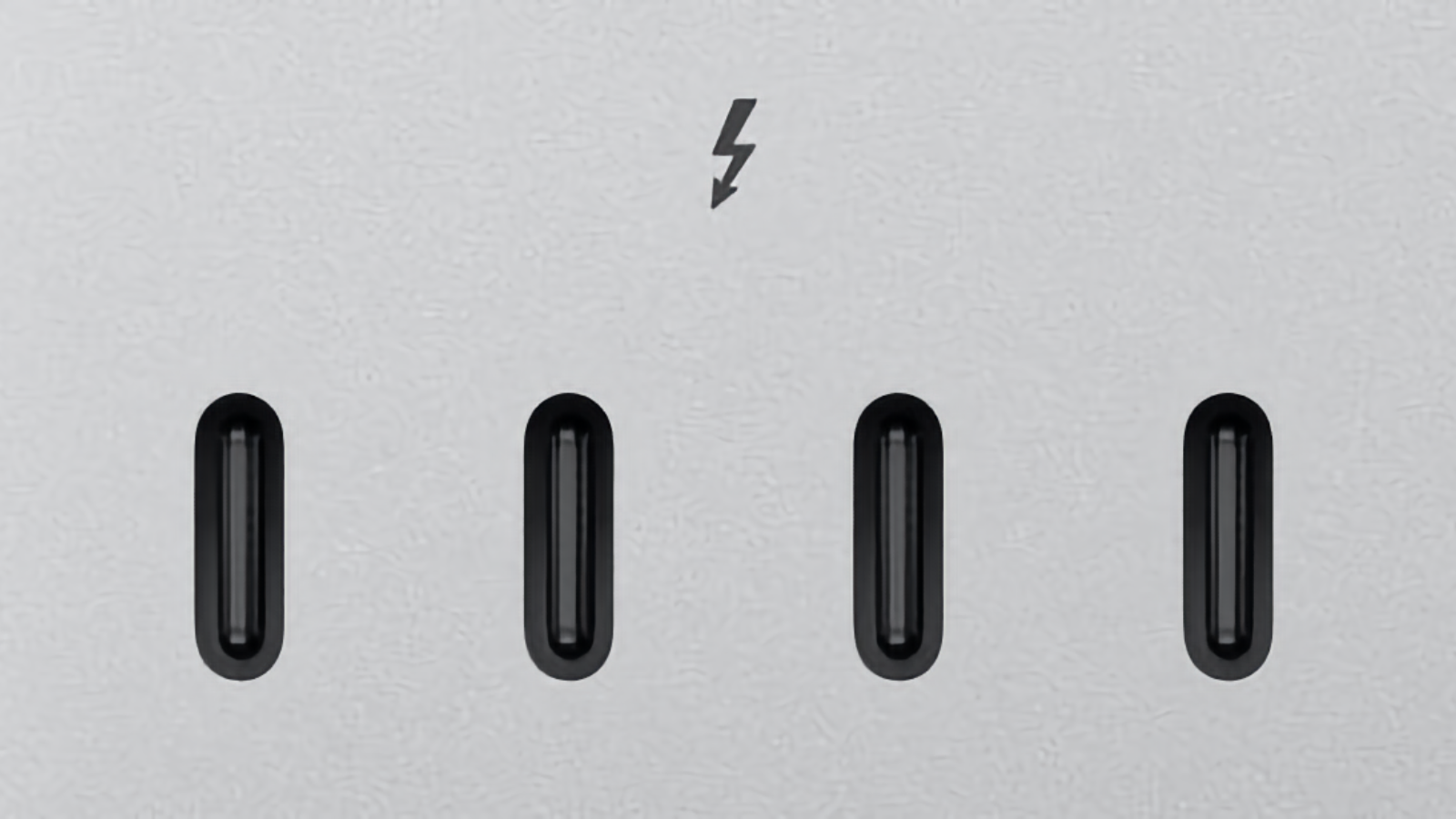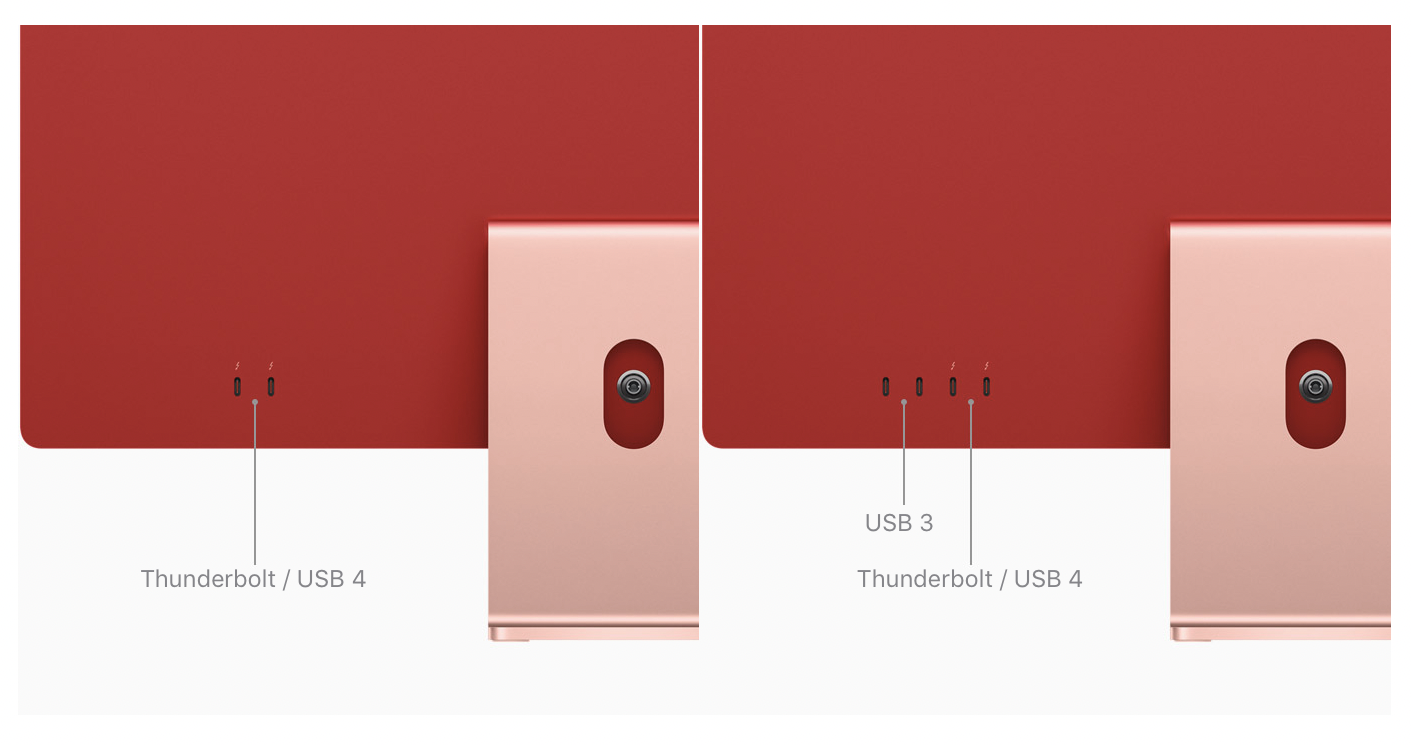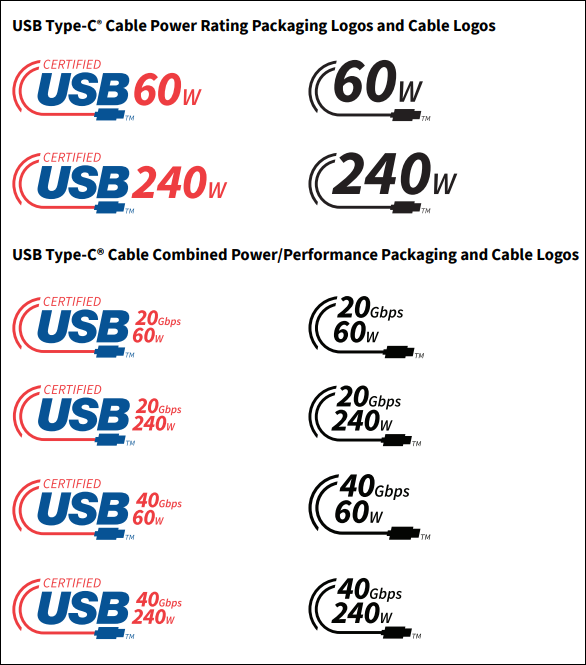USB-C and Thunderbolt: Understanding ports and cables for Macs, iPhones, and iPads
Posted on
by
Kirk McElhearn and Joshua Long

The ports that you use to connect keyboards, mice, and hard drives to your Macs have changed over the years. Current Macs have USB-C, which provide standard USB speeds, along with faster Thunderbolt to compatible peripherals. And many other Apple products use USB-C to charge and exchange data: most iPad models, and, starting in late 2015, the iPhone also eschews the lightning connector for USB-C.
But what’s the difference between USB-C and Thunderbolt ports, and how can you tell them apart? And which cables do you need to get the most out of them?
In this article, I’m going to explain what Thunderbolt and USB-C ports are, how to identify them, how they work, which features they offer, and how to choose the right cables for your needs.
In this article:
- A brief history of Mac data transfer ports
- What’s the difference between USB-C and Thunderbolt ports?
- How to choose the right cable?
- One cable to rule them all?
- Don’t forget dongles, adapters, and hubs…
- How can I learn more?
A brief history of Mac data transfer ports
Serial ports, SCSI, and USB 1.0
The history of personal computing has been marked by a series of milestones in data transfer capabilities. The earliest Macs could connect to cassette decks at paltry speeds. The 1983 Lisa had a serial port; this was long standard on computers to connect to peripherals. It also had a parallel port, to connect to a printer.
The Macintosh Plus added a SCSI port in 1986. This “small computer system interface” was a lot more flexible: it had faster throughput than previous ports, and you could daisy-chain devices.
Mac users lived with these limited options until 1998, when the iMac added USB ports. The first USB ports were slow, but this was a revolution.
FireWire 400 and 800, and USB 2.0
In late 1999, the first iMac with FireWire (also known as IEEE 1394) was released, although you could add a FireWire card to some Macs before then. This was the first taste of fast (for the time) data transfer on Macs. The FireWire 400 port ruled for years, and was supplanted by FireWire 800.
The numbers 400 and 800 indicated speeds in megabits per second, abbreviated Mbps. Note that data transfer speeds are usually measured in bits—not bytes—per second. One bit is one-eighth of a byte, so a 400 Mbps interface implied that you could theoretically transfer a 50 MB (megabyte) file in about a second (real-world speeds were somewhat slower, however).
Although USB 2.0 had a theoretical speed of up to 480 Mbps, FireWire was still faster at sustained data transfer.
USB 3.0 and Thunderbolt 1 and 2
FireWire ruled until USB 3 was added to Macs in 2011. This protocol provided data transfer rates of up to 5 Gbps (gigabits per second), and the ability to send data to displays. (Note that 1 Gbps is equivalent to 1,000 Mbps.)
At the same time, Macs started including Thunderbolt ports, with 10 Gbps throughput. Thunderbolt 2 came along in 2014, with up to 20 Gbps. The first two iterations of Thunderbolt used ports with a non-reversible connector, in the shape of the old Mini DisplayPort.
Thunderbolt 3, 4, and 5
Thunderbolt 3, in 2017, offered up to 40 Gbps. It was the first version of Thunderbolt to use the modern USB-C shaped ports with reversible connectors. As of early 2025, Apple still sells MacBook Air models with Thunderbolt 3 ports.
Thunderbolt 4, available on most Macs that Apple currently sells as of early 2025, maintains that 40 Gbps throughput. However, it also adds other features, including support for dual 4K displays. Furthermore, it includes protection against DMA attacks, to block attackers with physical access from reading or modifying computer memory—a potential problem with earlier Thunderbolt, FireWire, and even USB 4 standards.
Thunderbolt 5 is now available on a limited number of Macs, namely some MacBook Pro and Mac mini models with M4-based chips. The main difference with Thunderbolt 5 is that it supports up to 80 Gbps bidirectional data transfer, with peak transmission speeds of up to 120 Gbps. Thunderbolt 5 cables can theoretically be up to 2m in length, but in practice you likely won’t find one longer tham 1m, as of early 2025.
What’s the difference between USB-C and Thunderbolt?
Since Thunderbolt 3, the Thunderbolt protocol now uses USB-C style ports and cables. And that can be a problem; it’s confusing to have different but related technologies that share the same connector.
You used to know that if you could connect a USB cable, it would be able to transfer data at the speed of the USB interface. USB-C cables are different: some transfer more or less data, some also send power, at varying wattages, and some are actually Thunderbolt cables, supporting all of that protocol’s features.
And, by the way, the USB standard is now up to USB 4, which provides up to 40 Gbps throughput just like Thunderbolt 4.
The now ubiquitous USB-C port comes in many versions. Here’s an example of a recent iMac (24-inch, 2023). The less expensive model, at the left, has two ports, both Thunderbolt / USB 4. The more expensive model has four ports. (Note that only two out of the four ports on 2023’s model were Thunderbolt ports; on the November 2024 four-port model, all four are Thunderbolt ports.)

I mentioned the different data transfer speeds above, but there’s another factor to consider: how much power these ports provide. USB 3 and 4 ports can send from 4.5 W to 240 W, and Thunderbolt 3 and 4 can send 15 W, with Thunderbolt 4 providing one 100 W (potentially up to 140 W) port on a computer; Thunderbolt 5’s spec requires 140 W (and can potentially be up to 240 W). And this is bi-directional; you can charge a laptop by connecting a USB-C cable from a charger, and you can power peripherals, such as portable hard drives, using power from the computer. You think this is confusing? Have a look at this USB-C cable logo chart.

All USB-C cables, regardless of their data throughput and power rating, look alike; there’s no way to tell, when you look at a cable, what it is capable of. Some manufacturers are starting to add logos, similar to the ones above, to cables, but I bet you probably have a lot of USB-C cables already without logos. If you see a USB-C cable described as a “charging cable,” you should assume it’s not rated for data throughput. And some cables that are designed to send and receive data may only support low power levels.
And I haven’t even touched on using these cables with a display; while some displays can work with USB 3 connections, it’s more likely that a high-resolution display will require Thunderbolt. For example, to connect to Apple’s current Studio Display, you need a Thunderbolt 3 cable or better; this is, in part, because the display also provides 96 W power, so you can, for example, connect a MacBook Pro and use the display while charging the laptop.
How to choose the right cable
It can be confusing to choose the right USB-C shaped cable. Let’s start with Thunderbolt cables, and then move on to other USB cables.
Thunderbolt 3, 4, and 5 cables generally have the Thunderbolt logo, so you can be sure that it supports data transfer of up to 40 Gbps—but other specs may vary. Most Thunderbolt cables deliver power, though different cables may provide different wattages.
While Apple’s cables are more expensive than those of other manufacturers, you can’t really go wrong if you buy a Thunderbolt cable from Apple. The specs are clear, so you know what you’re getting. The only disadvantage is the price; we’ll get back to that in the next section of the article.

For plain USB-C, it’s a bit different. If you have a recent iPhone or iPad with a USB-C port, and either sync content from your Mac or back up your iPad to your Mac, then you know that data synchronization is quite slow. This is because the charging cable that Apple provides in the box only goes up to 480 Mbps. This low speed applies to both the USB-C (to USB-C) Charge Cable that comes with iPad models that have a USB-C port (not a Lightning port), as well as for the USB-C to Lightning Cable that comes with iPad models with Lightning ports (the latter cable also comes with iPhones).
If you have an iPad or iPhone with a Lightning port, these devices only support 480 Mbps data sync speeds, so don’t expect a third-party cable to make syncing any faster. And the iPhone 16 Plus and the base 16 model, which have USB-C ports, are limited to the slower USB 2.0 speed.
However, with recent iPad models, and with the iPhone 16 Pro Max and Pro, which have a USB-C port instead of Lightning, you can transfer data much faster—even at Thunderbolt speed—but you’ll need to buy a cable that supports it.
You don’t necessarily need to buy a Thunderbolt cable, but you might as well, given the similar pricing and potential to avoid confusion in case you re-purpose the cable in the future.
You can buy a cable from Apple or from a number of familiar, trustworthy brands, such as Anker, Belkin, CalDigit, Mophie, OWC, etc. If you sync often, you should get a cable that provides both power and better data throughput; this could be either an Apple Thunderbolt cable or one of the OWC or CalDigit cables mentioned in the next section of this article.
One cable to rule them all?
At this point, you might be asking yourself, why not buy Thunderbolt 5 cables exclusively? If a Thunderbolt 5 cable is backward compatible with Thunderbolt 3 and 4, and USB 4, and USB 3 with USB-C shaped ports, then why buy anything else?
The main answer is price—at least if you really want to buy a cable directly from Apple. If you don’t necessarily need Thunderbolt cables, but you have unlimited funds, you might not have any problem buying Apple’s Thunderbolt cables. Apple currently sells only one Thunderbolt 5 cable, 1m in length, for $69. (Apple also sells a CalDigit brand 1m Thunderbolt 4 cable for $49.95, if you don’t need Thunderbolt 5 and want to save $20.) If you want a longer cable than 1m, you’ll have to go with Thunderbolt 4 instead of 5; Apple sells a 1.8m cable for $129 and a 3m cable for $159.
If you want to synchronize data from an iPhone Pro (or Pro Max) or an iPad model that has a USB-C port (rather than a Lightning port), Thunderbolt cables will transfer data faster than the USB-C Charge Cable that Apple included with your device.
Speaking of which, Apple’s USB-C Charge Cable comes in 1m and 2m lengths at just $19 or $29 each, respectively. The 1m version supports power of up to 96 W while the 2m version supports 240 W, so if all you want to do is charge a USB-C device, and you don’t think you’ll ever use the cable to transfer data at high speeds, this is the least expensive Apple brand cable you can buy.
So, for most people, buying an Apple brand Thunderbolt 4 or 5 cable may only make financial sense if you own a compatible device and computer, and want to utilize features that are only available with one of the latest standards. On the other hand, Apple isn’t the only option; read on for lower-priced alternatives.
Cheaper alternatives to Apple’s Thunderbolt 4 and 5 cables
The prices of Apple’s Thunderbolt cable prices are a bit high. What if you could really buy “one cable to rule them all” at a single, reasonable price? Thankfully, Apple isn’t the only company that sells Thunderbolt 4 and 5 cables.
Both OWC and CalDigit sell high-quality Thunderbolt 4 cables for significantly less than Apple charges. OWC’s Thunderbolt 4 cables come in 0.7m, 1m, and 2m lengths, for $19, $28, and $58, respectively, each with a 3-year warranty. CalDigit’s Thunderbolt 4 cables are priced slightly higher, but are still much cheaper than Apple’s; they come in 0.8m and 2m lengths, for $30 and $60, respectively, each with a 2-year warranty. Both brands’ cables feature the Thunderbolt logo with a “4” beneath it, so you’ll always be able to easily identify exactly what kind of cable it is at a glance.
As of early 2025, CalDigit doesn’t currently sell Thunderbolt 5 cables, but OWC does. OWC’s Thunderbolt 5 cables come in 0.3m, 0.8m, and 1m lengths, for $20, $28, and $35, respectively, each with a 3-year warranty. Note that the 1m cable costs about half as much as Apple’s Thunderbolt 5 cable of the same length.
Given these much lower prices, if you’re willing to buy a cable from a trusted, third-party brand rather than from Apple, it’s actually pretty affordable to buy Thunderbolt 4 or 5 cables exclusively. You’ll know you’re getting the best quality cables regardless of how you may end up using them, while avoiding potential cable confusion in the future, at a decent price.
Don’t forget dongles, adapters, and hubs…
For many people, there aren’t enough ports on their Macs. With only two ports on the entry-level iMacs and laptops, and still just four on the more expensive models (with the exception of the Mac Studio), there’s a good chance you might run out of places to plug in your USB or Thunderbolt accessories. You can use a Bluetooth keyboard and mouse, but if you have other peripherals for interacting with your computer, such as a graphics tablet, that’s one port used. Do you use an external hard drive to store files or back up your data? That’s another port. And if you want to keep a cable connected to your Mac to charge your iPhone or iPad, that’s another one. These few ports get used up quickly.
In addition, it’s likely that many of your peripherals are not USB-C, but rather USB Type A (the old rectangular connector), requiring dongles to make the conversion. In general, dongles shouldn’t affect the speed or power going through the cables, but some may. If you need a USB-C to USB-A hub, make sure it supports at least USB 3.0, and preferably USB 3.2 (though this is only really necessary if you connect disks to the hub).
There are also a number of hubs that split out a single Thunderbolt cable into as many as a dozen ports or more. These hubs often have a wide variety of ports. For example, CalDigit’s Thunderbolt Station 4 offers 18 ports, including five USB-A for older peripherals, an Ethernet jack, audio in and out jacks, a DisplayPort, and two SD card slots, along with four USB-C ports. Devices like this are a great way to extend your Mac, though they are expensive, and you will likely not use all the ports on the device.
Now you know more about USB-C and Thunderbolt!
With every big change to the connectors we use for computer peripherals, there can be some difficulty adapting.
But after a wide array of plugs and jacks over the years, it looks like USB-C style ports and cables are here to stay for a while. Because this plug can handle both USB and Thunderbolt—and each new version of these standards offers backwards compatibility—it should be easier to manage over the coming years.
For now, you might still have some old peripherals that don’t use USB-C, so you might require a hub or adapters. But over time, you may find that you can use all your external devices with the same type of universal plug.
How can I learn more?
 Each week on the Intego Mac Podcast, Intego’s Mac security experts discuss the latest Apple news, including security and privacy stories, and offer practical advice on getting the most out of your Apple devices. Be sure to follow the podcast to make sure you don’t miss any episodes.
Each week on the Intego Mac Podcast, Intego’s Mac security experts discuss the latest Apple news, including security and privacy stories, and offer practical advice on getting the most out of your Apple devices. Be sure to follow the podcast to make sure you don’t miss any episodes.
You can also subscribe to our e-mail newsletter and keep an eye here on The Mac Security Blog for the latest Apple security and privacy news. And don’t forget to follow Intego on your favorite social media channels: ![]()
![]()
![]()
![]()
![]()
![]()
![]()